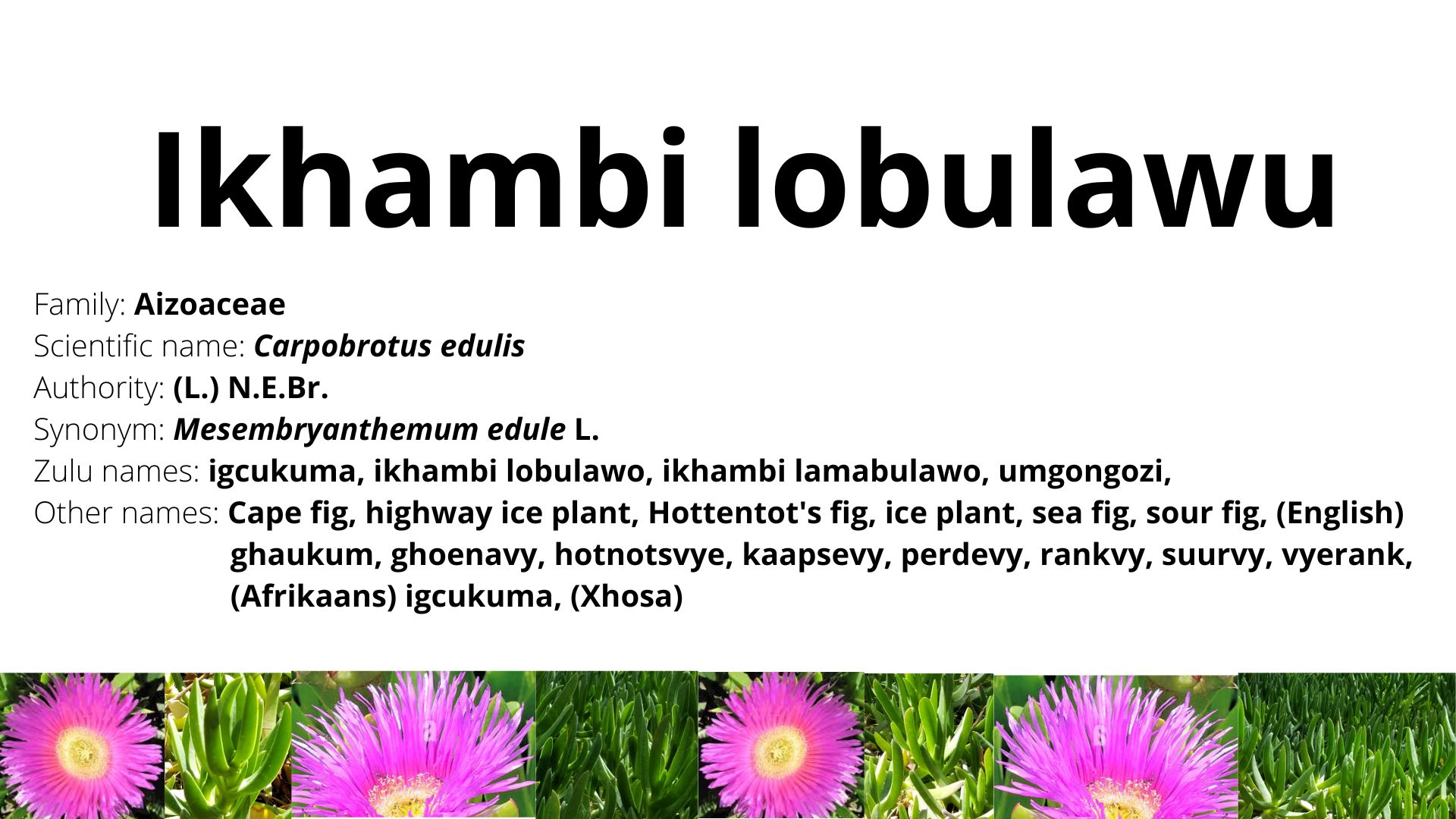Family: Aizoaceae
Scientific name: Carpobrotus edulis
Authority: (L.) N.E.Br.
Synonym: Mesembryanthemum edule L.
Zulu names: igcukuma, ikhambi lobulawo, ikhambi lamabulawo, umgongozi,
Other names: Cape fig, highway ice plant, Hottentot’s fig, ice plant, sea fig, sour fig, (English) ghaukum, ghoenavy, hotnotsvye, kaapsevy, perdevy, rankvy, suurvy, vyerank, (Afrikaans) igcukuma, (Xhosa)
Description: C. edulis is a fast growing evergreen succulent that occurs as a ground cover in the sand dunes. It is cultivated as a pioneer plant. And has fleshy triangular-shaped leaves, yellow flowers that open in the morning and closes at night, and fleshy indehiscent edible subglobose fruits.
Uses:
- The fruits are eaten fresh.
- The fruits are used to make jam and syrup.
- The fruits are used as a preservative.
- The fruits are used to add flavour.
- The roots are mixed with those of Bulbine asphodeloides roots to help manage the opportunistic infections (Ols) especially in people with weakened immune systems such as those living with HIV.
- The juice from the leaves is sucked to treat a sore throat.
- The juice from the leaves is mixed into a lotion and applied topically to treat bruises, burns, cracked lips, rash, sores, sunburns, and wounds.
- The juice from the leaves are used to treat itching caused by insect (spider and tick) bites.
- The leaves and stem are used to make a decoction to cleanse the body.
- The leaves and stem are used to treat teething and toothache.
- The leaves are used as an astringent and antiseptic.
- The leaves are ingested to treat diarrhoea, dysentery, and digestive problems.
- The leaves are dried and powdered used to treat oral thrush.
- The leaves are used to treat tuberculosis and respiratory infection.
- The plant is used to treat ringworm.
- The plant is used as an ornamental.
References and further reading:
- Akinyede, K.A., Ekpo, O.E. and Oguntibeju, O.O., 2020. Ethnopharmacology, therapeutic properties and nutritional potentials of Carpobrotus edulis: A comprehensive review. Scientia Pharmaceutica, 88(3), p.39.
- Arnold, H.J. and Gulumian, M., 1984. Pharmacoepia of traditional medicine in Venda. Journal of Ethnopharmacology 12, pp. 35–74.
- Buwa, L.V. and Afolayan, A.J., 2009. Antimicrobial activity of some medicinal plants used for the treatment of tuberculosis in the Eastern Cape Province, South Africa. african Journal of Biotechnology, 8(23).
- Hutchings, A., Scott, A.H., Lewis, G. and Cunningham, A., 1996. Zulu medicinal plants. Natal University Press, Pietermaritzburg.
- Omoruyi, B.E., Bradley, G. and Afolayan, A.J., 2012. Antioxidant and phytochemical properties of Carpobrotus edulis (L.) bolus leaf used for the management of common infections in HIV/AIDS patients in Eastern Cape Province. BMC Complementary and Alternative Medicine, 12(1), pp.1-9.
- Ndhlovu, P.T., Omotayo, A.O., Otang-Mbeng, W. and Aremu, A.O., 2021. Ethnobotanical review of plants used for the management and treatment of childhood diseases and well-being in South Africa. South African Journal of Botany, 137, pp.197-215.
- Van Der Watt, E. and Pretorius, J.C., 2001. Purification and identification of active antibacterial components in Carpobrotus edulis L. Journal of ethnopharmacology, 76(1), pp.87-91.

